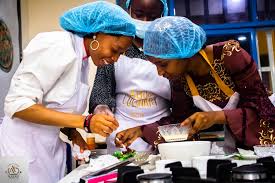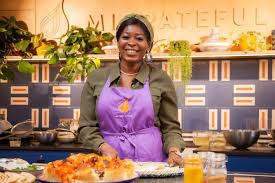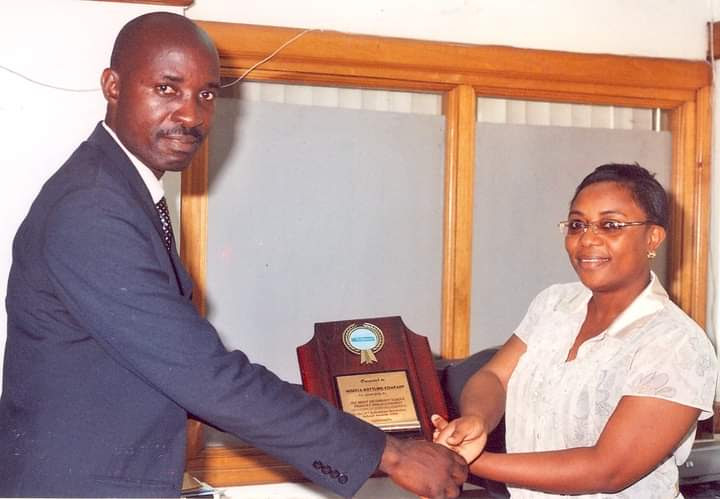![]()
If you’ve landed on this article page, you’re probably searching for a
good business idea—an idea that’s light on the pocket but heavy on
returns, promising both a fulfilling journey and potential profit.
|
How to Start a Cooking Class Business in
Nigeria
Starting a cooking class business can be an exciting and
fulfilling venture for those who are passionate about cooking
and teaching.
The cooking class industry has experienced significant growth in
recent years, fueled by the increasing popularity of cooking
shows, food blogs, and the desire for individuals to learn new
culinary skills. People are becoming more interested in
exploring different cuisines, honing their cooking techniques,
and embracing healthier lifestyles through cooking at home.
Defining Your Niche:. By identifying your target audience and
their cooking interests, as well as determining the type of
cooking classes you want to offer, you can position yourself for
success.
Identifying your target audience: Consider who your ideal
customers are. Are you targeting beginners who want to learn
basic cooking skills, or more experienced home cooks looking to
expand their culinary repertoire? Understanding your target
audience's skill level, age group, and preferences will help you
tailor your classes to their needs.
Assessing cooking interests: Determine the types of cuisines,
cooking techniques, or specific dishes that are in high demand
or align with your expertise. For example, you might focus on
baking, vegetarian cooking, international cuisines, or healthy
meal prep. This specialization will set you apart from general
cooking classes and attract customers with specific interests.
Market demand analysis: Research the local market to gauge the
demand for various cooking class themes. Look for gaps in the
market that you can fill with your unique offerings. This
analysis will help you identify underserved niches and potential
opportunities for growth.
Personal expertise and passion: Consider your own culinary
background, expertise, and passion. Capitalize on your strengths
and interests to develop classes that reflect your unique style
and knowledge. This will not only make teaching more enjoyable
for you but also enhance the authenticity and quality of your
classes.
Consider your target market: Choose a location that is easily
accessible to your target audience. If you are targeting busy
professionals, consider a location close to business districts
or residential areas. If your focus is on families, a location
near schools or community centers might be more suitable.
Kitchen requirements: Assess your kitchen requirements based on
the type and scale of cooking classes you plan to offer. Ensure
that the kitchen space is well-equipped with the necessary
appliances, utensils, and storage facilities. If you are renting
a kitchen space, negotiate the terms and conditions with the
landlord or kitchen owner.
Size and layout: Consider the size and layout of the space. It
should have sufficient room for cooking stations, seating areas
for demonstrations, and storage for ingredients and equipment.
Adequate ventilation and lighting are also important factors to
create a comfortable learning environment.
Parking and transportation: Evaluate the availability of parking
facilities or proximity to public transportation. Easy access
and convenient parking options can attract more customers,
especially for evening or weekend classes.
Cost considerations: Determine the rental or lease costs
associated with the location. Evaluate the overall affordability
of the space, including utilities, maintenance fees, and any
additional expenses. Balance the costs with the revenue
potential of your cooking classes.
Competition and complementary businesses: Research the presence
of competing or complementary businesses in the area. Proximity
to complementary businesses, such as specialty food stores,
kitchenware shops, or farmers' markets, can provide additional
foot traffic and collaboration opportunities.
Equipping Your Kitchen:
Focuses on equipping your kitchen with the necessary
tools and equipment to run your cooking class business smoothly
and efficiently. The right equipment will enhance the learning
experience for your students and enable you to demonstrate
cooking techniques effectively.
Basic cooking equipment: Invest in essential cooking equipment
such as stovetops, ovens, ranges, and microwaves. Ensure that
these appliances are in good working condition and suitable for
the types of cooking classes you plan to offer.
Utensils and cookware: Stock up on a variety of utensils and
cookware, including knives, cutting boards, mixing bowls, pots,
pans, baking sheets, and measuring tools. Opt for high-quality,
durable items that can withstand frequent use.
Small appliances: Consider including small appliances that are
commonly used in cooking classes, such as blenders, food
processors, stand mixers, immersion blenders, and electric
grills. These appliances can simplify certain cooking techniques
and expand the range of recipes you can teach.
Specialty equipment: Depending on the specific cooking classes
you plan to offer, consider investing in specialty equipment.
This may include pasta makers, bread machines, ice cream makers,
sous vide equipment, or espresso machines. Evaluate the demand
for these classes and the potential return on investment.
Kitchen tools and gadgets: Stock your kitchen with a wide range
of tools and gadgets, such as spatulas, whisks, tongs, peelers,
graters, and thermometers. These tools will be essential for
teaching various cooking techniques and preparing different
recipes.
Storage and organization: Ensure that you have adequate storage
space for ingredients, equipment, and supplies. Install shelves,
cabinets, and storage racks to keep your kitchen organized and
easily accessible.
Creating a Curriculum:
A well-designed curriculum will provide structure and
progression, enabling your students to learn and develop their
culinary skills effectively.
Determine class levels: Consider offering different levels of
classes to accommodate students with varying skill levels.
Common levels include beginner, intermediate, and advanced. This
allows students to progress and build upon their knowledge and
skills.
Identify learning objectives: Define the specific learning
objectives for each class. What do you want your students to
achieve by the end of the class? Learning objectives could
include mastering a particular cooking technique, understanding
flavor combinations, or creating a specific dish.
Plan class duration: Determine the ideal duration for your
classes. This could range from a few hours for a single-session
class to multiple sessions spread over several weeks. Consider
the complexity of the recipes and techniques being taught when
determining the class duration.
Select recipes and themes: Choose recipes that align with the
interests of your target audience and the goals of each class.
Consider different themes, such as international cuisines,
healthy cooking, baking, or specific dietary preferences. Ensure
that the recipes are suitable for the skill level of the class
participants.
Determine instructor requirements: Identify the qualifications
and skills you are looking for in potential instructors.
Consider their culinary expertise, teaching experience, ability
to connect with students, and knowledge of various cuisines and
cooking techniques.
Network within the culinary industry: Tap into your network of
culinary professionals, chefs, and cooking instructors to find
potential candidates. Attend culinary events, cooking
competitions, and industry conferences to meet talented
individuals who might be interested in teaching cooking classes.
Advertise job openings: Post job openings on relevant platforms,
such as culinary job boards, local job portals, or social media
groups. Clearly outline the qualifications, job
responsibilities, and application process to attract suitable
candidates.
Marketing and promotion: Develop a targeted marketing strategy
to promote your culinary retreats. Leverage your online
presence, social media platforms, email newsletters, and
collaborations with travel bloggers or influencers. Highlight
the unique aspects of your retreats, the expertise of your
instructors, and the beauty of the destination.
Age-appropriate classes: Design classes that cater to different
age groups, ensuring age-appropriate recipes, techniques, and
activities. Consider classes for young children (e.g., 4-7 years
old), pre-teens (e.g., 8-12 years old), and teenagers (e.g.,
13-17 years old).
Safety considerations: Prioritize safety in kids' cooking
classes. Ensure a clean and safe environment, use child-friendly
equipment, and teach basic kitchen safety rules. Supervise
children closely during hands-on activities and guide them
through safe food handling practices.
Get our Practical Training guide on How to set up a Cooking
Class Business in Nigeria. The Cooking Class business plan
provides a detailed roadmap for entrepreneurs seeking to dive
into the Cooking Class Industry in Nigeria. The plan offers an
in-depth analysis of essential commercial elements, equipping
you with actionable insights to build a robust foundation for
your venture. It meticulously explores the nuances of your
business idea and considers the local market dynamics,
competitive landscape, and the driving forces behind market
growth.
|







